How To Keep 2 Powered Rails Separate
Information technology has been suggested that this page be merged with Tutorials/Train station.[discuss ]
If this merge affects many pages or may potentially be controversial, do not merge the page until a consensus is reached.
It has been suggested that this page be dissever into Minecart/Mechanics .[discuss ]
If this split may potentially be controversial, do not divide until a consensus has been reached.
![]()
This commodity needs cleanup to comply with the way guide.[discuss ]
Delight aid improve this page. The talk page may contain suggestions.
Reason: Separate minecart mechanics and mechanisms
This tutorial covers basic minecart stations and systems and is designed for those without significant redstone knowledge and just minor experience with minecarts and rails. This tutorial doesn't touch furnace or storage minecarts. Images below do not ever evidence a space-saving pattern, but rather ane that makes all components immediately visible.
Contents
- one Absolute basics
- 1.1 Minecarts
- 1.2 Runway
- two All-time practices for laying tracks
- 3 Powered rails
- 3.ane Behavior
- 3.2 Powering
- iii.2.1 Momentum
- iii.3 Climbing slopes
- 3.four Optimal use
- 3.five Usage of detector rails
- iii.6 Additional properties
- 4 Parts of a simple organisation
- iv.1 Powered rail mechanisms
- 4.ane.1 Stop points
- 4.ane.2 Starting boost
- 4.ane.3 "Whirligig" cyclical minecart accelerator
- 4.2 Launcher
- 4.3 Rider detection
- 4.3.one Empty carts
- 4.4 Boosters
- iv.5 Junction
- 4.6 Multiple destination selector
- 4.7 Piston commodities
- iv.1 Powered rail mechanisms
- 5 Troubleshooting
- half dozen See besides
- vii References
Absolute basics [ ]
Minecarts [ ]
The post-obit are the most important properties of minecarts.
- Minecarts motion at eight m/s at top speed on a direct rail. On a diagonal track they motion at 11.314 m/due south = sqrt(2) * eight.
- Minecarts move differently depending on their load.
- A minecart with a role player inside travels 309m from full speed, staying at full speed for 176m.
- A fully loaded hopper or chest minecart travels 40m from full speed.
- An empty hopper or chest minecart travels 165m from total speed.
- A chest minecart carrying 320 items (5 stacks) travels 101m from total speed.
- Activated powered rails, down slopes, and being pushed by players or mobs add together momentum to a cart, increasing its speed.
- A minecart with a player inside goes from stationary to full speed afterwards near 13m of powered rail.
- A histrion riding in a cart may add momentum past "pushing" it using the forrad control.
- A stretch of an unactivated powered rail of at least ii blocks length brings a loaded cart at full speed to a complete halt.
- A long stretch of rails or an upwards-slope reduces a cart's momentum and thus its speed, eventually stopping it unless the forward cardinal is held throughout past a player riding the cart.
- Minecarts "bounce" off of obstructions on the track. Running into a thespian, mob, or a stopped cart causes information technology to reverse direction, even on a powered rail.
Rails [ ]
Delight see the individual pages for each type of runway for information on their properties and bones usage:
- Rails ever take to sit on another solid block and are the only track type that tin can curve.
- Detector runway give off a redstone signal when a cart passes over them, otherwise they act every bit a regular runway.
- Powered rails add together momentum to a cart passing over them when powered, when unpowered they accept a braking action and slow or even stop a cart.
- Activator rails trigger an action on a cart passing above them when powered: TNT minecarts are fix off, a hopper cart gets deactivated, and players/mobs riding in one are pushed out of information technology.
The rest of this folio discusses the use of these components in building tracks and rail transport systems.
Best practices for laying tracks [ ]
The performance of a rail line is affected by the way the rails is placed. Turning next to a wall (see below) or having hills to climb adversely affect the speed of a cart, and so its distance traveled.
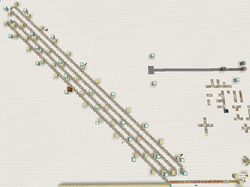
Some YouTube videos suggested that diagonal rail might offer amend performance than straight runs, this has not been proven to exist the case. Another distance trial rail was synthetic with a length of 300 blocks. Carts with no rider travel the same distance as on the straight track, about 18 blocks before they cease, and a cart with a player riding can arrive to the end of the track. The interaction with blocks adjacent to the track seems to be a little stronger with carts on a diagonal track. With lampposts placed only every x blocks along the track an unmanned cart could cover only 12 blocks, and with a thespian riding just over 180 blocks, a significant reduction.
What the tests have confirmed is the increase in speed. On each curved track, a cart effectively moves ii blocks, thus its maximum speed is 11.314 m/due south, an comeback over the maximum of eight m/s on a directly track.
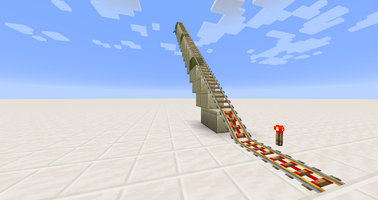
A minecart with no rider, at full speed, can climb 10 blocks on unpowered, upwardly sloping rail. This suggests that powered track is needed at this height only to go along a cart climbing. Notwithstanding, the cart slows so much that it can reach only another five blocks high with 2 lengths of powered track starting at ix blocks high. Further testing showed the minimum number of powered blocks to keep the cart climbing well is 3 powered rails every half dozen blocks starting at 9 blocks loftier, at the cost of a strong reduction in speed. To maintain speed in a climb a ratio of 5:4, powered versus regular runway segments, is a good compromise for decent speed at a reasonable price, starting with 2 powered rails on the flat before the upward slope to be certain the cart starts the climb at maximum speed.
If construction cost is no object one can of course utilise powered runway all the way to the top to get the best possible performance.
Carts with a passenger, or chest carts, have more than momentum and so climb higher than one that is unloaded. With a passenger, a cart tin climb at least 24 blocks before needed powered rails to become higher.
Running a track next to a wall makes no deviation to the speed of progress, merely an side by side one-cake-high wall significantly slows down a cart if the cart is pointed at the wall while inbound a plow or "diagonal" section.
Powered rails [ ]
Behavior [ ]
Powered rails may be activated by redstone to plow them "on" which makes them able to add momentum to carts already moving over them. When unpowered they are "off" and strongly reduce the momentum of a cart passing over them.
Note that a minecart placed on an agile powered runway cannot move as information technology has no motion for the powered rail to add to. Once the cart is pushed, its rider uses a forwards or backward move, or a block placed at one of its ends, the cart's direction of motion is set and the powered rails can affect it.
If a cart is placed on an inactive powered rail that is sloped the braking effect is strong enough to continue it stationary against "gravity". if the powered track is then turned on gravity is enough to first the cart rolling downhill, which then causes the rail to affect the cart's momentum.
A rail that is "off" slows carts passing over it every bit if by friction. A single inactive rail is plenty to completely halt a cart in most cases. Carts that are loaded and/or at full speed cannot be stopped by just ane block, but ii "off" rail tin terminate information technology. On a long downslope, a stretch of three inactive runway are required to exist sure of halting a speeding, loaded cart.
Powering [ ]
Power can exist transmitted to the runway from any of the half-dozen side by side positions (higher up, below, or any side) in the aforementioned fashion redstone is powered.
Powered track propagate power to each other if they are side by side and part of the same track, for upwards to 9 blocks from the power source (ane being powered straight which is propagated to viii adjacent runway). They also receive ability from any adjacent detector rails (when a cart passes over it), even if they are not part of the same rail (which follows from the rules above). Considering the detector rail powers fastened rails, it could be used to activate power rails only when necessary:
- For 1-way travel, identify a detector rail before the powered rails
- For ii-way travel, place a detector rail on both sides of the powered rail
In practice, information technology is far more efficient to take powered rails constantly active using other means:
- Place a redstone torch either next to the powered rail or 2 blocks underneath information technology or utilize powered redstone wiring to attain the aforementioned effect
- Place an activated lever on the bottom side of the block the powered rail is on (cheapest, requires only a stick and a cobblestone to make)
- Place the powered rail on a block of redstone
Momentum [ ]
The speed of a cart which is boosted using Powered Rails is calculated to be at the maximum of 8 m/southward, withal, the cart maintains an internal "momentum" value that keeps the cart at the maximum speed of 8 m/s until the excess momentum is depleted.
A unmarried powered rails on the flat ground confronting a stop cake gives an occupied cart enough momentum to travel 80 track tiles on a flat surface, or 8 tiles for an unoccupied cart (in Beta 1.five, this was 64 blocks and 8 blocks respectively). Tests testify that putting several powered rails in a row has observable diminishing returns with each additional powered runway on how much further a cart travels.[i] This implies that the momentum gained is smaller if the cart'due south speed is faster and vice versa.
Tests bear witness that climbing slopes bear upon momentum severely, thus the cart speed plummets fast. However, if in that location is enough surplus momentum, carts easily travel upwards slopes. Conversely, carts traveling downwardly slopes proceeds momentum. Downward sloped powered rails add both the momentum from the runway and the momentum from going downhill to your cart.
Climbing slopes [ ]
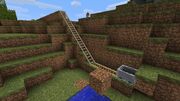
6 blocks up without additional boosting in Beta 1.five, 10 in Beta 1.6
Launching from rest via 4 powered rails, an occupied cart has enough momentum to climb a 1/1 gradient 10 blocks high without further boosting so travel horizontally at a very slow speed for at to the lowest degree a dozen blocks before coming to a stop. Such a cart does not have plenty momentum to climb an 11 block loftier slope. An empty cart in a like setup can climb only 5 blocks so travel a few blocks horizontally.
When minecarts travel upslope without having sufficient stored momentum, a powered rail is needed 1 every 4 blocks to sustain move all the way to the top of the slope, Alternatively, 2 every 8 blocks are somewhat easier to supply power to (note that this doesn't seem to be working every bit of patch 1.xiv.four, and may require additional testing) However, annotation this is a worst-case scenario where there is no momentum to first with.
If working with empty carts (for example, a storage cart transport system), i powered every 2 blocks is necessary to sustain the movement. To minimize powering requirements, 2 powered followed by 2 unpowered tin also be used (analogous to loaded player-carrying carts).
When traveling up a gradient at full speed (8 m/s) one powered rail is sufficient to maintain full speed for 2 blocks high, meaning that alternating betwixt powered and unpowered rails maintains full speed up a slope. Sequent powered rails on a slope adds more momentum, so eight powered rails can exist followed by 8 normal rails to maintain full speed while traveling upward the slope. Less momentum is gained by each consecutive rails as the strip gets longer.
Optimal utilise [ ]
Experiment information
A test was conducted by building straight tracks 2000 blocks long on level ground with different intervals of powered rails. The time to travel the full 2 km length on a actor/mob occupied minecart was recorded with each interval. The post-obit table lists the results:[2]
| Powered rail spacing | Fourth dimension to travel ii km | Speed | % Slowdown |
|---|---|---|---|
| 1 every 32 or fewer meters | 250 seconds | 8 m/s | 0% |
| 1 every 33 meters | 252 seconds | 7.94 m/southward | 0.eight% |
| ane every 34 meters | 250 seconds | 8 thousand/s | 0% |
| 1 every 35 meters | 253 seconds | 7.91 g/due south | 1.2% |
| 1 every 36 meters | 251 seconds | 7.97 m/south | 0.iv% |
| i every 37 meters | 252 seconds | vii.94 yard/s | 0.8% |
| 1 every 38 meters | 251 seconds | 7.97 chiliad/s | 0.4% |
| 1 every 39 meters | 258 seconds | seven.75 m/south | 3.one% |
| 1 every 40 meters | 259 seconds | 7.72 m/due south | three.v% |
| 1 every 41 meters | 263 seconds | 7.6 g/south | 4.nine% |
| 1 every 42 meters | 267 seconds | 7.49 m/s | 6.four% |
| i every 43 meters | 270 seconds | 7.41 thousand/s | 7.iv% |
| 1 every 44 meters | 271 seconds | vii.38 m/s | vii.7% |
| one every 45 meters | 281 seconds | 7.12 1000/s | 11% |
| Powered runway spacing | Time to travel 2 km | Speed | % Slowdown |
|---|---|---|---|
| one every 46 meters | 281 seconds | vii.12 m/s | 11% |
| 1 every 47 meters | 290 seconds | 6.9 m/s | 13.viii% |
| 1 every 48 meters | 301 seconds | 6.64 one thousand/s | sixteen.9% |
| ane every 49 meters | 306 seconds | 6.54 m/southward | 18.iii% |
| i every fifty meters | 308 seconds | 6.49 m/s | xviii.8% |
| 1 every 51 meters | 306 seconds | half dozen.54 one thousand/due south | 18.3% |
| 1 every 52 meters | 314 seconds | half-dozen.37 thousand/s | 20.4% |
| i every 53 meters | 311 seconds | 6.43 m/s | xix.six% |
| i every 54 meters | 319 seconds | 6.27 thousand/s | 21.vi% |
| 1 every 55 meters | 322 seconds | 6.21 m/s | 22.4% |
| ane every 56 meters | 319 seconds | 6.27 1000/s | 21.six% |
| 1 every 57 meters | 333 seconds | 6.01 m/south | 24.9% |
| 1 every 58 meters | 339 seconds | five.9 yard/south | 26.three% |
| 1 every 59 meters | 345 seconds | 5.viii m/s | 27.5% |
The time to travel the total 2 km length is different for all the other minecart type, requiring more powered rails to achieve the top speed of 8 m/south. The post-obit table lists the data collected: [3]. Note that the optimal rail spacing for a fully loaded cart differs, see the original reference for details.
| Powered track spacing | Time to travel 2 km | Speed | % Slowdown |
|---|---|---|---|
| 1 every 27 or fewer meters | 250 seconds | 8 thou/due south | 0% |
| 1 every 28 meters | 256 seconds | vii.82 m/due south | ii.three% |
| ane every 29 meters | 260 seconds | 7.71 m/south | 3.vi% |
| 1 every 30 meters | 262 seconds | 7.64 m/s | 4.5% |
| 1 every 31 meters | 262 seconds | 7.65 m/s | 4.4% |
| 1 every 32 meters | 266 seconds | 7.54 m/s | 5.eight% |
| one every 33 meters | 270 seconds | 7.41 thou/southward | 7.iv% |
| 1 every 34 meters | 275 seconds | 7.28 m/s | 9% |
Three powered rail in a row on flat terrain is sufficient to boost all minecart types from rest to the maximum speed of viii m/southward.
Thereafter, the optimal spacing of powered rails on a level track is to apply 1 every 38 blocks for occupied carts (that is, a repeating pattern of ane powered rail followed by 37 normal rails, then some other powered rail, and so on) which maintains a constant minecart speed of 7.97 m/s. If gold is in curt supply, it is possible to use powered rails with more space between them at the toll of reduced overall speed (see above). If y'all definitely must have the full 8 m/s you should identify a powered rail on a level track 1 every 34 blocks for occupied carts.[2]
For all other (utility) minecart types, the optimal spacing of powered rails on a level runway is to apply i every 27 blocks for empty utility carts (1 powered rail followed by 26 normal rails). A full utility minecart requires much more at ane every 6 blocks.[3]
An optimal use requires the synchronization of minecart movement and powered rail placement; moving a powered rail a single block frontward or dorsum forth a rail tin can make a significant difference. This is considering the momentum of a minecart is increased per tick (=one/20 of a second) the cart spends on a powered runway (past 0.nine m/s for occupied carts). When a cart travels at the maximum 8 m/south on a straight track, it alternately spends either 2 or 3 ticks on each block. For optimal placement, the powered rail must be put where the cart spends 3 ticks, otherwise, one-third of the boost is wasted.
A diagonal track is a track that consists of the blueprint 'left corner' attached to a 'right corner' attached to a 'left corner' then on. When minecarts travel on a diagonal track, the camera is held steady in the diagonal direction and the minecart visually travels diagonally along the rails besides. The speed limit of minecarts is actually 8 yard/s per cardinal axis, thus when traveling on second tracks, the cart travels 8 m/s in both cardinal directions of travel to result in a net vector of about 11.3 m/s or the square root of 128. With a 3D runway, you travel equally fast as 13.85 g/south or the square root of 192.
Considering of this difference, there is also a difference between the optimal spacing of powered runway when used on a 2D runway when compared to straight travel on apartment terrain. You demand powered rail every 53.7225 (rounded to 54) curved rail. This tin can be worked out through ratios, comparing 8m/s for 38 rails (the optimal distance for straight rails) to 11.31m/s to work out the value of 53.7225. Therefore for a combination of directly and curved, a curved track is equivalent to 0.707 of a direct rail. To maintain maximum speed, yous must keep the value under 38. For example one combination could be 31 straight rails with 10 curved rails as this is the equivalent of 38 direct rails.
There is also a difference in unmanned (empty) or storage minecarts, so a shorter interval is needed if these carts are expected on the runway. The optimal pattern to make storage minecarts move chop-chop is three:1 (1 powered rail every 4th block). Compared to shorter intervals, the reduction in speed is minimal. The widest possible interval seems to be eight:1 (ability every 9th block) -- any longer, and the minecart does non reliably reach its destination. In practise, seven:1 may exist meliorate, as an 8:1 pattern volition accept empty carts coming nearly to a stop betwixt the powered rails, and volition neglect given whatever interference whatsoever.
Usage of detector rails [ ]
A detector rail can power 4 side by side blocks and ii blocks beneath it when a minecart, occupied or empty, is on it. This makes it possible to actuate powered runway inline without redstone torches or wiring.
A detector can be used to activate adjacent powered rails. However, if the detector is used to actuate more than two or three (depending on arroyo speed) powered runway, the rail conciliate before the minecart reaches them, bringing the cart to an immediate terminate.
One-way powered rail lines tin can be created by placing a detector rail before a powered rails. This way, occupied carts are boosted simply if they are traveling the proper direction. Carts going the "wrong" way come up to a terminate because the powered rail is inactive.
Although inefficient, A two-manner rail line can be created by placing detector rails on either side of the powered track.
Alternately, placing powered and detector rails on a i×1 slope does not propel a cart more than iii blocks upward if there is non enough initial momentum. The cart loses too much speed on the incline, meaning information technology can't make information technology from the detector rail to the powered runway before the powered track returns to the "off" state. If the cart is in a railroad train of two or more than carts, the last cart in the railroad train becomes stuck instead.
A detector rails could likewise be used to actuate an issue based on a cart'southward location. For example, a fail-condom can be created to release a stopped cart in guild to prevent a collision with an arriving cart. The arriving cart passes over a detector rail, activating a powered rail that boosts the resting cart away.
Additional properties [ ]

Powered rail do not curve similar other rails.
Curved ability rails exist in merely the case where the final direction is toward the east (with the powered rail appearing in the north-s orientation), or in a T-junction where ane path faces e along a north/south runway.[4] [5] It is possible to brand a one-way curved railway using power track, just not a bi-directional ane.
When placing rails, regular runway adopt to curve toward the powered rail. In cases such equally these, the south-west dominion applies.
A cart reverses direction when it collides with an object (wall, single block, thespian, other carts) while traveling on a powered rail. It does not reverse management if it collides with a translucent block, such equally rock slabs or glass. If a rail including powered rails is bordered past blocks acting as "buffers", the cart continues dorsum and forth along the track indefinitely. Having carts interact with each other on a short track designed this style can exist used to chain multiple carts together as a "train". Once aligned, they all move together at relatively the same speed.
How far the charge passes downwardly adjacent rails is contained of the length of redstone wire. Even if the rails are continued to a redstone torch by 15 blocks of redstone grit, the viii adjacent rail still receive ability despite the fact that they should be out of range for the torch.
Parts of a simple organisation [ ]
Powered rail mechanisms [ ]
Stop points [ ]
Information technology is possible to make points in your track where a cart is stopped and then jumpstarted again by player input. This can exist useful for creating checkpoints to certain sites of involvement in your world. This tin can be done past using ii powered rails pieces on a one-block incline, by having the first powered track piece going downward, with the second powered rails piece at the bottom and a push placed alongside the second powered runway slice, then that the push is direct above the track.
-
An example of a end betoken
When the cart comes to this point, information technology stops on the incline, allowing the cart to utilize gravity to start the boost when the push is pushed. Players tin and then either stay in the cart and carry on to the next end, or leave the cart at the station for themselves/other players to use subsequently.
A "two-way" terminate tin be made by combining two of the normal stops with a detector rail in betwixt. This pauses a minecart traveling in either direction and allow them to exist restarted by pressing a button.

Ii-way minecart terminate
Starting boost [ ]
To create a elementary initial boost device using 2 powered rails, dig a pigsty ane block deep and 2 blocks long. Place the powered rails within the trench, connect one cease to the rails that you wish the minecart to exit. Finally, identify the minecart on the powered rail. In one case power is practical to the runway, the minecart is additional out.
When 1 terminate of a powered track has a solid cake placed side by side to it a stationary cart on it gets accelerated away from the block. In that location are two common ways to exploit this beliefs:
- Unpowered runway at the beginning of a rail line with a non-transparent block next to information technology. Place a cart on it and apply a redstone signal to the block to launch the cart.
- Powered rail at the start of a runway line with a block flush to the ground next to it, and an upwards-facing piston under the block. When a cart is placed on the track, a redstone bespeak to the piston raises the block and to provide the initial push button to start the cart moving.
"Whirligig" cyclical minecart accelerator [ ]
With simple switching, a minecart can be temporarily diverted into a small loop of powered rails and left there to accelerate. After a filibuster, which can be achieved with either repeaters or a hopper timer, a 2nd switch can be activated to fix the minecart loose downwards the track. Using this method, with fairly pocket-sized delays (in the range of 10-twenty seconds) a set of four powered rails can be used to propel a minecart at full speed for several hundred blocks, thus vastly exceeding the efficiency of placing powered track along the rail.
Launcher [ ]
Launchers, stations or exits all refer to a point in the system where a rider can safely enter or exit a minecart. They generally use a button to launch the cart.
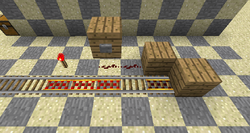
A simple minecart launcher
This first blueprint uses a push button, a few powered runway, a bit of redstone wire, and a redstone torch. The button powers the powered rail which launches the cart away from the solid block behind it. In this style of launcher, it is important for an incoming minecart to brand information technology all the way upwards to the back block and so it can easily be launched once more.
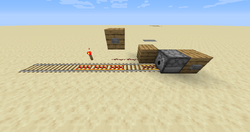
A launcher with cart dispenser
This second pattern is essentially the aforementioned as the commencement. A dispenser replaces the solid block behind the last powered rail. The dispenser launches the minecart just like the solid block, but creates a convenient place to shop actress minecarts. To actuate, apply the button behind the dispenser to cause a minecart to popular onto the rail, ready for utilize.
Passenger detection [ ]
Players may want to detect whether a cart contains a player, because empty carts tin can clog a rail system. This is referred to as passenger detection.

Trip wire based design
A trip wire based blueprint is quick to ready and reliably detects a thespian. Even so, information technology doesn't notice some non-histrion mobs, specifically 'short' mobs (wolves, spiders, pigs, etc.).
To build, a tripwire is attached to hooks one block above the track. 2 blocks further is a junction which is fix by default to turn empty carts dorsum to the station. An empty minecart does not trigger the tripwire, so it is sent back. An occupied minecart crossing a tripwire sends a short pulse to the junction and go along along the remainder of the track.
Depending on orientation, the signal may need to be inverted with a redstone torch. The torch adds a small-scale delay, simply this shouldn't touch the results. This design assumes the minecart is moving at top speed. If your minecart is moving slower than that, you can either add delay to the wire using repeaters or increment the speed of the minecart with a booster just earlier the tripwire.
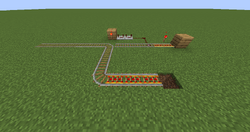
A momentum based pattern
Another method to check for a passenger is to have advantage of the modify in the speed of the cart, as an empty cart slows downwards more rapidly. In this pattern, a minecart creates a pulse when it passes the detector rail. If the minecart is empty, it gets to the turn just as the signal does and be sent back. If the minecart has a rider, it gets to the turn before the signal and be able to keep on. This pattern requires the track to exist set by default to permit the cart through.
Empty carts [ ]

An overflow pile for empty carts
When an empty cart is detected, generally it's a skilful thought to send it into an overflowing pile. An overflow pile is a drop of two or more blocks with a rail at the bottom. When carts are boosted into the hole, they snap to the track, regardless of how many carts are already on the runway. This pile should exist placed where the carts tin can be nerveless, either shut to a station or in a maintenance area. It is important to heave carts to full speed simply before they are dropped to ensure they don't become stuck on the end of the track and eventually back up the system.
Another variant of this method is to replace the rail at the lesser with a cactus, thus destroying minecarts that fall in. Placement of a hopper next to the sand on which the cactus is placed then allows saving of at least some of the carts.
A dispenser loaded with fire charges break minecart entities, dropping them as items. Placing a detector rail higher up a hopper, with the dispenser facing the detector runway, collects minecarts equally items, which can and so be stored in a chest or routed to a cart dispenser.
Boosters [ ]
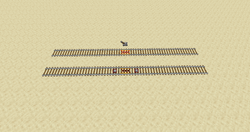
Two styles of speed boosters
Boosters are a method used to preclude carts from slowing to a cease on a track. Considering carts eventually irksome to a halt on level track, and very quick turn around on regular runway track while uphill-jump, boosters are a method of assuring one's cart keeps moving. Boosters accelerate carts to a terminal velocity of 8 thou/due south, as they use powered track, and help finer counter the forces of friction and gravity on the acceleration of the cart. Boosters are simply a single powered segment of powered rail, powered through detector rails, redstone torches or levers next to them. Refer to the diagrams to the right. Players generally keep the altitude betwixt boosters uniform, although these distances vary by player. One common, and according to many, the most efficient, distribution of powered rails is to place powered rail every 38 blocks on level ground. An easy way to place a lot of track using this count without needing to keep track of each runway is by dividing the rails into stacks of 37, every bit shown on the correct. Approximately 1 out of every 3 rails must exist powered to travel uphill due to gravity.
Junction [ ]
Stations often have one line leading to one destination. Multiple destinations require multiple lines. A junction is a fork in the rail where the rider can select which destination they wish to visit.
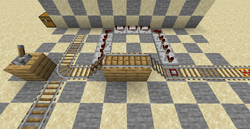
Two-mode junction
This design uses a lever to switch the runway. The powered rail becomes powered after a preset delay. The detector rail starts the delay. In this blueprint, the lever always points toward the selected destination regardless of management.
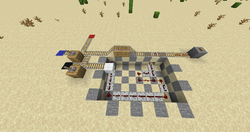
Iv-manner junction
A junction that has multiple destinations tin can be set upwardly past expanding the junctions. In the design to the right, the rider is given much more time to select their destination than a two-way junction. They can select any destination by first selecting left or right, then forrard or astern. This design doesn't scale well just can be used in sequence to create any number of destinations.
Multiple destination selector [ ]
There are many, many styles of minecart destination selectors. Most are modular, meaning they tin can be extended to include more destinations. An RS-NOR latch array is frequently used to select a destination as these latches have a designated reset line (as opposed to a t-flip flop which has only one input).
This design was selected for its simplicity and for its ability to be expanded with relative ease. One of the buttons on the selection panel is a designated reset line since additional input doesn't clear the previous selection; that is to say, a player can select more i destination with this pattern (although a launched minecart takes the left-nigh of the selected destinations).
"Video Tutorial" by CNB
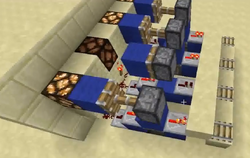
The interior of the second design
The following pattern is heavily influenced past the previous but uses a unlike RS-NOR latch blueprint involving pistons. Information technology has a reset integrated in the choice such that a new input clears the previous i. By removing the designated reset line of the previous version, it allows for an additional station in a similar corporeality of space.
Piston bolt [ ]
This consists of a lot of curved tracks and many pistons. The pistons push the minecart extremely quickly down the line.
| YouTube Video (view on YouTube) |
|---|
Troubleshooting [ ]
When a track system isn't working properly, it tin be hard to set up for someone unfamiliar with redstone and runway. Common solutions include:
- Irresolute the delay of the excursion by adding a repeater or moving a detector rail to trigger earlier.
- Changing the speed of the minecart by adding powered rails or moving the current ones farther abroad.
- Checking that powered rails are powered properly.
- Plow the pattern effectually, every bit direction can affect how it works. Mostly, this isn't the outcome, but it's good to dominion information technology out.
Searching on the minecraft forums can help. If you demand to create a new mail service, be sure to include the direction you're working (the F number), every bit directionality tin can be a gene in the blueprint.
Meet also [ ]
- Minecart
- Runway
- Tutorials/Storage minecarts
- Tutorials/Train station
- Tutorials/Building a rollercoaster
References [ ]
- ↑ http://world wide web.minecraftforum.net/topic/270836-all-near-powered-rails-thread/page__view__findpost__p__3989800
- ↑ a b http://world wide web.minecraftforum.net/topic/366339-taviriders-world-of-scientific discipline/
- ↑ a b http://www.reddit.com/r/Minecraft/comments/3ja6qc/peak_efficiency_with_powered_rails_v_20_updated/
- ↑ http://www.youtube.com/watch?5=f_p4Sk6Ie84&NR=1
- ↑ http://www.minecraftforum.net/viewtopic.php?f=1020&t=300356
Source: https://minecraft.fandom.com/wiki/Tutorials/Minecarts
Posted by: walshfrivis.blogspot.com



0 Response to "How To Keep 2 Powered Rails Separate"
Post a Comment